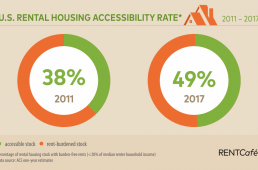
December 14, 2018 | by Katie Claflin
Categories: Affordable Housing, Rental Housing
Housing affordability is generally measured by calculating the percent of income a household pays toward their housing costs. The rule of thumb is that housing is considered affordable if the household pays no more than 30% of their monthly income toward on their housing.
RENTCafé, a national apartment listing service, argues that this measurement only tells part of the story and isn’t particularly effective when determining the overall affordability of a given community.
To fully understand the affordability of a specific area, RENTCafé asserts that you have to also look at the “accessibility rate”, defined as the percentage of all apartments that are affordable when factoring in the median income for the area.
Using data from the American Community Survey, RENTCafé reports that, from 2011 to 2017, the median gross rent nationwide rose by 16%. At the same time, the median gross income for renter households grew 26%. The high increase in median renter income as compared with housing costs means that the percentage of renters who could afford their housing costs increased by 11%-- from 38% in 2011 to 49% in 2017.
This measurement leads RENTCafé to draw the following conclusion: high accessibility rates are driven more by solid incomes than by cheap rents.
According to RENTCafé, one of the reasons behind the increased accessibility rate is that renting across all income levels has become more popular over the past decade. The evolution of the tech industry has compounded this phenomenon by offering competitive salaries in urban areas and recruiting young professionals, many of whom are renters.
Here’s how the largest cities in Texas compare based on the accessibility rate measurement. With the exception of El Paso, the accessibility rate in all Texas cities improved or stayed the same from 2011 to 2017. Furthermore, five of the seven cities have accessibility rates higher than the national average of 49%.
While the increased accessibility rate is encouraging, a national accessibility rate of 49% still means that 51% of renter households cannot reasonably afford their housing costs. To address this ongoing concern, TSAHC continues to provide financing options to local developers to increase the supply of affordable rental housing in communities across Texas.
On the House blog posts are meant to provide general information on various housing-related issues, research and programs. We are not liable for any errors or inaccuracies in the information provided by blog sources. Furthermore, this blog is not legal advice and should not be used as a substitute for legal advice from a licensed professional attorney.
TSAHC reviews all blog comments before they are posted to ensure a positive experience for our online community. Off-topic comments; hostile, derogatory or deliberately insulting comments; and comments specifically promoting goods and services will not be posted.
Approved comments will be published in their entirety. Personal information will not be removed unless it pertains to someone other than the person submitting the comment. For more information, please see our Comment Posting Guidelines.
To remove a previously submitted and published comment, please contact Anna Orendain at [email protected].
If you have a question regarding any of TSAHC's programs, please contact us.

Apartments, nor homes are “Affordable”, in Waco, TX!